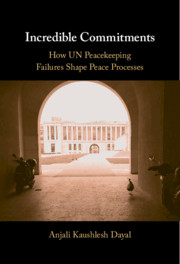Book contents
- Incredible Commitments
- Incredible Commitments
- Copyright page
- Contents
- Tables
- Acknowledgments
- 1 Introduction
- 2 The Social Context of International Peacekeeping and the Alternative Benefits of Bargaining
- 3 Methods and Case Selection
- 4 The Arusha Negotiations, 1990–1994
- 5 Guatemala, 1989–1996
- 6 Conclusion
- Bibliography
- Index
3 - Methods and Case Selection
Published online by Cambridge University Press: 02 October 2021
- Incredible Commitments
- Incredible Commitments
- Copyright page
- Contents
- Tables
- Acknowledgments
- 1 Introduction
- 2 The Social Context of International Peacekeeping and the Alternative Benefits of Bargaining
- 3 Methods and Case Selection
- 4 The Arusha Negotiations, 1990–1994
- 5 Guatemala, 1989–1996
- 6 Conclusion
- Bibliography
- Index
Summary
Chapter 3 lays out the methods and the logic of case selection that underpin the book. This book is a theory-building and theory-probing undertaking—I build a theory of how the alternative benefits of bargaining lead combatants to seek out UN peacekeeper while probing how the credible commitment theory of war termination drives the desire for peace operations—and process tracing using a most-similar cases approach is one way to do this.In this chapter, I outline first the method by which I selected cases, building a catalogue of the UN’s peacekeeping successes and failures, and a timeline of what peacekeeping successes and failures combatants would have seen around the world as they were negotiating, in order to do so, and then discuss the evidence and tools I use to process-trace the Rwandan and Guatemalan peace processes. Readers who are interested primarily in the substance of the text and not in methodological discussion, or a discussion of multiple archives, can proceed to the subsequent three chapters without reading Chapter 3.
Keywords
- Type
- Chapter
- Information
- Incredible CommitmentsHow UN Peacekeeping Failures Shape Peace Processes, pp. 53 - 78Publisher: Cambridge University PressPrint publication year: 2021

